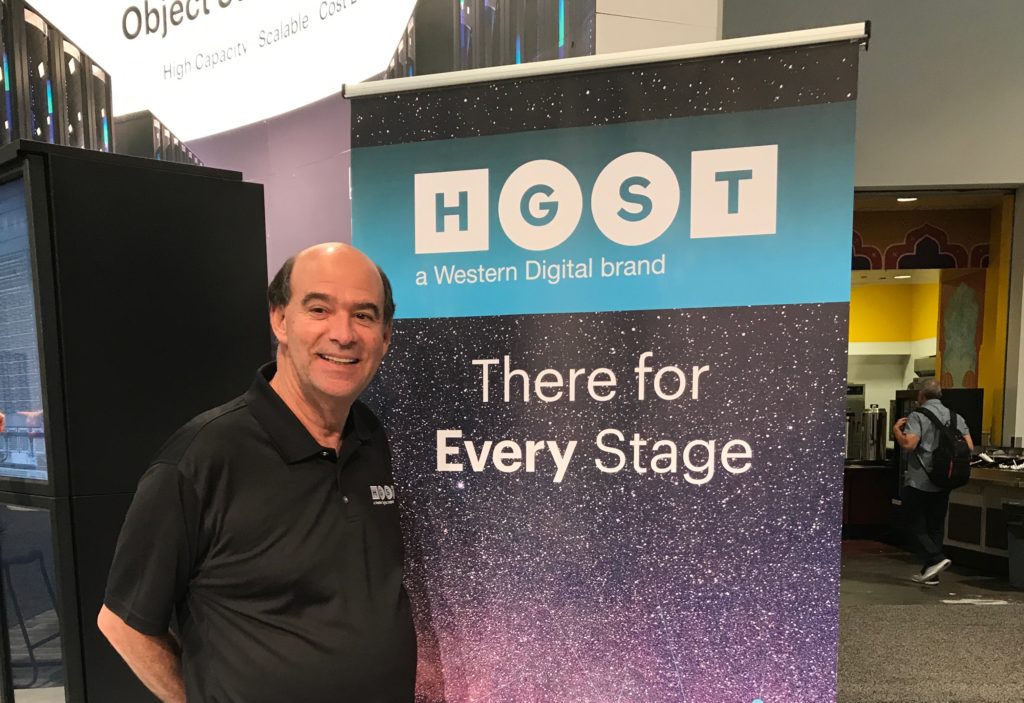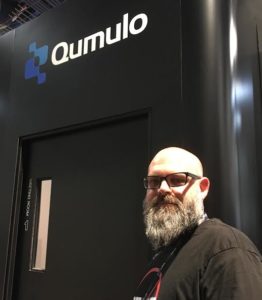M+E Connections

NAB 2017: Tata Communications to Enter eSports Arena; Western Digital’s HGST Tackles UHD Storage Needs
Story Highlights
LAS VEGAS — Tata Communications is looking to capitalize on the soaring popularity of eSports and plans to offer services to help game companies broadcast competitive events globally, according to a company executive the Media & Entertainment Services Alliance (MESA) interviewed at the NAB Show April 26.
The interactive game industry in general is “growing immensely” on a global basis, Brian Morris, VP and GM of Global Media & Entertainment Services at Tata, said. He pointed to the growing presence of freemium games like those played by his 10-year-old son — digital titles that are initially free to start playing, but require players to pay for virtual weapons and other extra items to advance further.
But “the thing that really captivated me” was when Morris saw the picture of a stadium filled to capacity with people watching an eSports competition in which kids were playing games against each other, he said, noting that game companies want to stream these events “across the world.”
“Video-rich” applications that are “growth-oriented” and appeal to youths globally, like eSports, fall into Tata’s wheelhouse, he said, telling us: “Our strength is a global network that can take you to every place on the planet.” The company “can take any piece of video, we can secure it for you, we can store it for you, we can re-format it, and we can get it ready for redistribution and monetization,” he said.
Tata sees eSports especially as a “pretty large” opportunity, he said, calling it a “multi-billion dollar business and growing,” with compound annual growth of more than 10%.
Tata is working with “multiple” game companies for eSports and other services, he told us, adding it was too soon to identify any of them. The initiative, which started about six months ago, represents the first time that Tata has worked with game company clients, he said.
With its data centers, Tata will also enable the game makers to enter new markets, by helping them with such functions as localization, he said.
Tata is also stepping up its Ultra High-Def (UHD) service initiatives this year because 4K applications are “real now,” he told us, adding: “We’re in the process right now” of working with multiple customers who are creating UHD content – mainly sports and movies.
“We tried to anticipate what the market’s going to do,” so — two years ago — Tata offered transcontinental UHD feeds for Formula One out of Singapore as a proof of concept, he said. Since then, demand for UHD services has become “heightened,” largely due to consumer demand as 4K TV pricing has significantly declined, he told us. “I think consumers are looking for rich content and I think content providers are trying to provide premium services” for them, he said. He predicted of UHD broadcasts: “Once some companies start to launch, many will follow.”
Tata, meanwhile, announced at NAB that it was chosen by VICE Media to build a “high-performance, completely cloud-based platform for global media asset management, storage, content contribution and distribution.”
Tata “will enable VICE Media to capture content anywhere in the world, and quickly make it available to hundreds” of editors in production centers in New York City, Los Angeles, Washington D.C., Toronto and London, for publishing and broadcasting across VICE Media channels, Tata said in a news release.
The new platform is “underpinned” by Tata’s Media Ecosystem that it said offers VICE a full set of media solutions, including the Video Connect service that complements VICE’s local area network and provides a global area network of video contribution and IP connectivity.
Tata said: “With speeds of up to 10 Gbps, Video Connect enables a seamless transfer of video files and remote collaboration between VICE Media teams across different geographies as if they were in the same location.”
The Media Ecosystem is also equipped with Tata’s IZO Cloud Storage that Tata said provides VICE with “secure, reliable private cloud-based media storage for read-write access and archival of data-intensive video files.”
Previously, some of those files were stored on-premise, and Tata said that “made teamwork challenging between different studios.” All VICE files, including videos in HD and UHD, are also now replicated in multiple private cloud locations around the world in real-time for back-up and disaster recovery, Tata said. Tata also said it integrated VICE’s media asset management and file acceleration tools into the new platform, creating an end-to-end solution for about 5,000 VICE employees globally.
Also at NAB:
HGST
At the 2017 NAB Show, HGST is demonstrating how it’s enabling production, broadcast and distribution companies to work more efficiently by delivering fast, flexible and scalable storage for every stage of the workflow, it said.
From object storage and all-flash arrays to hybrid cloud storage solutions, Western Digital’s HGST brand is leading discussions and spotlighting partnerships, customers and solutions that it said enable the media and entertainment market to “create, leverage and preserve data while improving productivity and lowering” total cost of ownership for 2K, 4K, 6K, high frame rate and Ultra High-Def workflows.
“I like to tell people that we have two kinds of storage: it either spins or it doesn’t spin,” Jeff Greenwald, senior director of market development at HGST, told MESA at the show, adding: “We are a significant manufacturer of stuff that spins and we are a pretty significant manufacturer of stuff that doesn’t spin. We intend to be competitive, as well as world-class, in both.”
Just ahead of NAB, HGST introduced next-generation versions of its flash technology and object storage products, he noted, adding that the latter “spins and the flash technology obviously doesn’t spin.” Those products already started shipping, he told us.
 From a corporate standpoint, “we’ve been a manufacturer of components for 50 years,” and Western Digital was a pioneer in the disc drive space, he said, adding: “We’re adding more and more value by going up the stack, by putting more and more platforms and systems together and delivering them to end users, to OEMS and to the channel.” In some cases, he said, these “comprehensive” systems “integrate storage with software, storage with compute, storage with all the different analytic components that our end-user enterprises want.”
From a corporate standpoint, “we’ve been a manufacturer of components for 50 years,” and Western Digital was a pioneer in the disc drive space, he said, adding: “We’re adding more and more value by going up the stack, by putting more and more platforms and systems together and delivering them to end users, to OEMS and to the channel.” In some cases, he said, these “comprehensive” systems “integrate storage with software, storage with compute, storage with all the different analytic components that our end-user enterprises want.”
In addition to the media and entertainment sectors, HGST is also focused on the telecom sector, he said. “It doesn’t matter if you’re a broadcaster, or if you’re a post house, or you’re a movie house, or … you’re a network – you’re involved in either creating video content or delivering video content and everywhere in between,” he said, noting HGST “addresses every stage of the media workflow,” and provides storage “for every stage.”
“That’s our focus” at NAB and HGST executives are meeting with a wide range of such companies at the show, he said.
HGST will now also “customize products if that’s what our customers want,” to meet their unique needs, he said, explaining: “As we go up the stack, the value is not just selling a brick. We’ll sell you a brick for $50. [But] we want to actually add more value around the brick. So, we will do integration, we will do certification, we will do product validation, we will do product testing, and we’ll also actually manufacture and integrate the system at our manufacturing shop, so that when it’s delivered to the customer, all they have to do is plug it in and it already has been pre-tested.”
Asked what the largest challenges facing HGST and the industry overall today are, he said: “Keeping up with the dramatic change that’s happening in the industry: changes in regulations, changes in security, changes in some of the protocols, changes in some of the industry standards. Just keeping current is a big, huge challenge.” And that, he said, was “the same challenge our customers have.”
He added: “The second biggest challenge is that our customers are looking for open standards that enable three things simultaneously. One is highest performance. The second is longest period of preservation. One hundred years from now, they want this data — these files – to be totally accessible by whatever systems are in place” at that time. “And they also want it at the lowest cost,” he said, noting “if they spent $12 last year, they actually want to spend $11 this year.”
HGST benefits from the fact that its parent company has some “phenomenal” intellectual property and continues to file a “significant numbers of patents,” he said. Some of that IP is developed internally, while others come from the acquisitions of companies that “bring some amazing technology – such as our acquisition of SanDisk, which has now been fully integrated into our company,” he said.
The company filed several patents late last year relating to higher-performance flash and higher density storage, he pointed out.
The company is performing research and “delivering the next-generation technologies,” he said. For instance, it recently announced 12 and 14-terabyte disc drives, and drives will continue to increase to “bigger and bigger densities,” he said, adding “the acceleration of densities in storage actually make us better positioned to continue our growth into the marketplace.”
Qumulo
In a huge win for Qumulo, it and Hewlett Packard Enterprise were selected by DreamWorks Animation to accelerate the studio’s digital content pipeline.
 “For us, it’s a big deal because DreamWorks is one of the top three film animation studios in the world and they do not typically” make announcements of this type, Nate Odell, Qumulo senior director of marketing, told MESA at NAB.
“For us, it’s a big deal because DreamWorks is one of the top three film animation studios in the world and they do not typically” make announcements of this type, Nate Odell, Qumulo senior director of marketing, told MESA at NAB.
DreamWorks is a “big name account” that is “doing a lot of really cool projects” using Qumulo Core software, he said, adding: “It’s just the beginning” of the relationship. Prior to this pact, DreamWorks was “one of our very early customers” about 2 ½ years ago, although that relationship wasn’t announced publicly at the time, he noted. The joint solution of HPE Apollo Servers and Qumulo Core software enables DreamWorks Animation to replace legacy storage systems used for HPC file-based workloads including data-intensive simulations for animated films and programs, Qumulo said in a press release, adding DreamWorks Animation was “challenged to keep pace with the vast amount of small file data generated from animation rendering workflows.”











